C.L.R. Peterson's Blog, page 4
July 8, 2021
Compassion or Collapse!
How would you describe the current mood in your part of the world?
In many places, today’s theme might be division rather than unity.
Is our time unique?
Over the centuries, internal divisions accelerated the decline of many powerful civilizations—ancient Greece, the Roman Empire, China’s Shang Dynasty, the British Empire, among many others.
Today’s book review focuses on France, with a riveting novel, The Brethren, (first of 13 in the Fortunes of France series) painting a picture of how religious and political conflicts between Catholics and Protestants led to decades of religious wars, many deaths, and the dissolution of French national unity.
To help our nations avoid these pitfalls, may we treat our neighbors with love and respect, whatever our differences!
Readers, what ways have you found to show compassion to your neighbors?
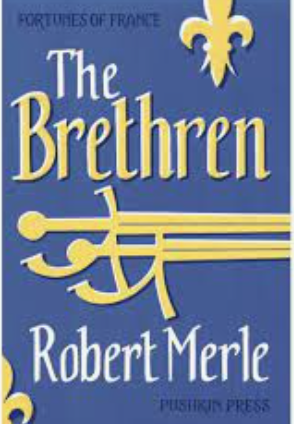
Pierre de Siorac, the second son of a fervent Protestant father and no less devout Catholic mother, tells the story of his Protestant (Huguenot) family in Périgord, France. Through his adolescent eyes and the difficult choices he, his family members and household face, readers see how the religious conflicts between Catholics and Huguenots threaten to tear France (and Pierre’s family) apart. This novel shows the very real impact of religion on the lives of common people as well as elites in 16th-century France—for instance, converts to the Huguenot faith lost 50 holidays (celebrating Roman Church saints) each year.
The Brethren begins a saga about France’s history. Although the novel’s rich background is closely based on facts, the author labels it as historical fiction, allowing him to fictionalize the family at the heart of this story. The author’s detailed portrayal of life details, history, and religious practice lays the groundwork for the French religious wars and their aftermath.
Clearly-drawn characters with strong, distinct perspectives and goals breathe life and emotion into this novel, drawing readers through decades of shifting policies of rulers, military commanders, clerics and lay religious leaders.
I recommend The Brethren to readers who enjoy an expansive story that transports them to a bygone era, and I look forward to reading the next volumes of this saga.
My rating: Life in this era was often messy and violent, so readers shouldn’t be surprised to encounter violence and intimacy outside marriage in The Brethren.
The post Compassion or Collapse! appeared first on C.L.R. Peterson, Author.
June 7, 2021
Enjoy great historical fiction this summer!
How will you relax, if you have the opportunity, after many difficult months?
I offer two suggestions for your reading enjoyment, both historical fiction, but each quite unique, followed by an interview with author Maryann Philip.
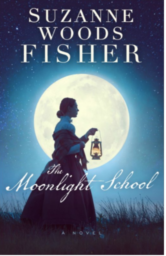
The Moonlight School, by Suzanne Woods Fisher
This entertaining novel, set in early twentieth-century rural Kentucky, sheds light on both the area’s strengths and weaknesses. Its focus, Moonlight Schools, was inspired by Cora Wilson Stewart’s real-life crusade to wipe out illiteracy.This story will appeal especially to readers of Christian historical romance novels.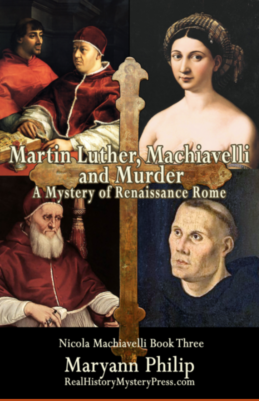
Martin Luther, Machiavelli and Murder, by Maryann Philip
Who would have thought that Martin Luther, Machiavelli, the Renaissance artist, Raphael, and various cardinals and popes would feature as characters in the same mystery story? Author Maryann Philip uses her creative magic to weave these diverse historical personalities, as well as major fictional characters such as Machiavelli’s mistress and their daughter, Nicola (the protagonist), into an imaginative yet not incredible plot.This novel will appeal to readers who enjoy an engaging, sometimes earthy, Renaissance-era mystery that will keep you guessing until the end.AUTHOR INTERVIEW WITH MARYANN PHILIP:
What led you to set your novels in the High Renaissance period?
The High Renaissance was my focus as a history major at Stanford, because it was the dawn of the modern age and an optimistic period of extraordinary intellectual and artistic achievement.
Why did you choose Renaissance Rome as the main setting for this novel?
It didn’t happen that way. I focused on Niccolò Machiavelli as the hub to my historic wheel, because he went everywhere and knew all the powers-that-be in Renaissance Italy. Machiavelli is very well-documented once he lands on the historic stage, however, so he could not be my primary character.
Instead I chose his fictional mistress (he had several) and illegitimate daughter (none known but certainly possible) as my protagonists. Why? Primarily because I love stories of strong women, and include real ones in these “real history mysteries” whenever possible.
The first story I wanted to tell was that of the Borgia family, and their interaction with Leonardo da Vinci. That required placing Machiavelli’s fictional daughter Nicola in Rome, at the convent where Lucrezia Borgia hid out while her first husband and father Pope Alexander VI fought about her divorce, and she gave birth to the child of another man. (Real history. Too racy not to tell! I have actually been to the convent, which still exists.) Nicola’s mother had to be in Milan, where Leonardo da Vinci was at the time, until he went to Rome to work for Cesare Borgia, as historic fact. All roads lead to Rome and ultimately all the characters ended up there. I made Caterina’s husband the last murder victim, so she could remain there as a widow working for the next “warrior” pope, Julius II. That gave me the backstory that continues through the rest of the series.
Does this novel work well as a stand-alone, or do you recommend reading A Borgia Daughter Dies and Da Vinci Detects first?
All the novels in the series were drafted to read as stand-alones. The backstories of the main characters are consistent and evolve with the characters, however. You will recognize them and know their histories if you read any other book in the series.
What’s your process for creating plots involving famous historical figures? How do you keep their characters true to what’s known about the real people?
The plots derive from the story I want to tell. For example, in Martin Luther and Murder, I wanted to describe what horrified Martin Luther when he traveled to Rome as a devout young monk in 1509, inspiring him later to equate the Pope with the anti-Christ. That led me to dive into what was happening in 1509 in Rome, a story complicated by the fact that Pope Julius was actually leading papal armies against Bologna when Martin Luther was there, waiting with other monastics for him to return so they could meet with him. I therefore had to send Nicola’s mother Caterina to Bologna in order to write about Pope Julius II.
To get their personalities right, I read the best biographies I can find, and compare them. I also read some original documents. I have read many though certainly not all of the commentaries in Leonardo da Vinci’s famous codices, for example. And many of the writings of Martin Luther.
What sources helped you fill in the details of daily life for this story?
That’s hard. There are not too many social histories of ordinary life in Renaissance Italy. Two books I have found helpful are Law, Family and Women: Toward a Legal Anthropology of Renaissance Italy by Thomas Kuehn and The Structures of Everyday Life 15th-18th Century by Fernand Braudel.
Did you know how this novel would end before you began to write? Did your plot change as you wrote?
For each book I have to know first what real history I want to explore. That dictates who my murderer and murder victim(s) will be, which I have to know before I can start writing. That and the real history are the constraints that drive the plot. I knew, for example, exactly when Martin Luther arrived in Rome and when he left, a fact derived from his correspondence. The mystery had to be solved between those two dates. And the first victim had to be someone high in the Church to introduce the scandals that Luther was exposed to while visiting Rome.
How much did you have to deviate from history to create a satisfying story?
I try not to do it at all. I will take sides and often minority positions on historical controversies, which is more fun than simply repeating the conventional wisdom. I will also fill in gaps in the historical record. But I disclose when I am taking a minority view and any “cheats”–even down to minor discrepancies in dates— in the Afterword at the end of each book.
What were the most challenging aspects of writing?
The hardest work is being consistent with the real history, especially squeezing or expanding the story to comply with the dates. Some authors of historical fiction don’t bother, but this is important to me.
What did you enjoy most about writing this novel?
The money I made from A Borgia Daughter Dies allowed me to travel to Bologna and Pavia to envision these cities for the book.
What do you hope readers will take away from this story?
I call my “real history mysteries” candy-coated history and my hope is always that readers will learn some real history that is new to them. Many Catholics have been taught that Martin Luther was a monstrous revolutionary, who destroyed a church that would have remained whole, but for him. I tried to show him as I believe he was: a traditional and earnest Catholic scandalized by the terrible corruption in Rome, concerned with the sale of indulgences and increasingly uncertain about the worship of relics, both practices that Catholicism has since abandoned. Understanding this background helps explain how much tinder was lying around when Luther unwittingly struck the match.
Is there anything else you’d like to say to my readers? If you read any of my books and like them, please put up a review. The reviews are the only advertising I do. Martin Luther and Murder has not sold well. I would love to change that!
Readers, please share your favorite historical fiction reads this summer!
The post Enjoy great historical fiction this summer! appeared first on C.L.R. Peterson, Author.
May 8, 2021
People, Places, Times
People, places, historical objects, or time periods—which interests you more when you’re choosing a novel?
This month, we’re focusing on a recent trend—time-split novels, in which stories from the past impact the present, sharing a key element: often a place, sometimes an object, person, or theme.
A few examples:
Heidi Chiavaroli, The Tea Chest
Melanie Dobson, Memories of Glass
Laura Morelli, The Night Portrait
Debbie Garneau Griffin, The Eternal Conductor
What sparked my interest?
The two time-split novels I’ve read most recently:
The Eternal Conductor, which came out this spring. I was fascinated by its focus on the sites and participants in the Underground Railroad, which helped enslaved people escape to freedom, especially in the decades before the Civil War.The Night Portrait, which focuses on a Renaissance painting and its fate over the centuries.Personally, when I read a time-split novel, I prefer a greater focus on the distant past than the more recent period.
Readers, how about you?
Do you enjoy novels set entirely in one era, or do you prefer novels combining at least two time periods?
Keep reading for an interview with Debbie Garneau Griffin, the author of The Eternal Conductor. Also see her website: https://theeternalconductor.com/ (Rating information for readers: This novel contains scenes that include violence, sexuality, and profanity.)
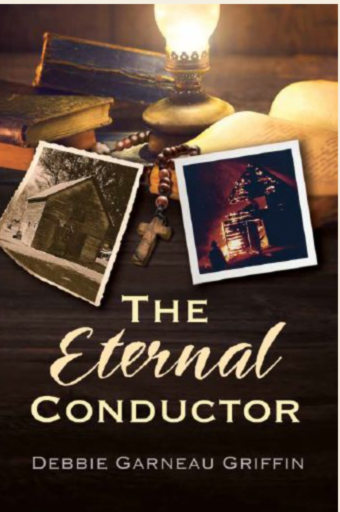
My interview with author Debbie Garneau Griffin:
What drew you to a story set in Vermont in the 1850s?
Debbie Griffin: When I decided to write about the Prescotts’, a fugitive slave family seeking freedom in Canada, I decided to begin the story in October of 1850, where the family arrives during the night at a waystation in Vermont. The reason I began then is because in September, 1850 the Fugitive Slave Act went into effect in the country. It offered a bounty on any blacks who were captured, regardless of whether they were free or not. Plus, anyone not helping law enforcement capture runaways could be fined up to $1,000. Previous to the Act, fugitives could travel ‘above board’ in the North with little fear of slave hunters. Once the Act went into effect, it pit neighbor against neighbor and fugitives had to be hidden on their route to Canada.
Was there a triggering event that prompted you to begin writing?
DG: My single mother and I lived in a two-story farmhouse in Vermont, which was also inhabited by a spirit, who told us he was there to protect us from evil. We would also discover that he had a mean streak! In the mid-1990’s I had to move mom to a nursing home. In the process of cleaning out the property, we discovered a hidden chamber beneath the barn, which contained a number of items. Enlisting the help of the local historical society, we were able to determine it had been used to shelter fugitive slaves on their quest for freedom in Canada.
How did you discover a new angle about the Underground Railroad that hadn’t been written about?
DG: Well, I thought our experience of discovering our property had once been a waystation along the UGRR was interesting, and not completely unique in the Northeast. Many families harbored fugitives and properties are still being discovered that were part of their travels. I thought it an interesting premise to build the story upon.
How much did you have to deviate from history to create a satisfying story?
DG: A number of the characters in Part I, which begins in 1850, are true life Founding Fathers of Fair Haven, Vermont. They were staunch abolitionists as well as prominent business men in town. I kept their attitudes true to their beliefs as I included them in the story. The story of the escaped slave family, the Prescotts’ is based upon a compilation of multiple stories I researched, and is true to form in the history of Vermont.
Did you need to visit archives, or were most sources available online or in books from libraries?
DG: Initially when we discovered the history of our property, I thought it was
‘neat’, but didn’t have time to dwell on it as I had to get back to work in California. It was only after I retired from Silicon Valley, that I got more interested in the UGRR routes. I made numerous trips to Vermont, New York and Canada researching, as much of the history was kept ‘below the vest’. There are two museums where I researched their archives, which was a wonderful trove of information: Rokeby Museum near Burlington, VT https://rokeby.org/
And North Country UGRR Museum in upstate New York.
https://northcountryundergroundrailroad.com/museum.php
I also visited local libraries and private citizens whom had letters and documents of their family’s involvement in the abolitionist movement.
Were there points in your writing when you couldn’t find information you thought was critical to the story? If so, what did you do?
DG: I’ll admit that I took too much for granted as to what had or had not been invented in 1850. One of my critique partners, Peter, is British. At one point, I had Emma, the Conductor’s wife, making a pot of tea using tea bags. Upon reading the passage, Peter immediately informed me that tea bags weren’t invented until 1870! Who knew? After that, I became very careful about how I depicted daily life in the mid-1800’s to ensure that it was as authentic as possible. This is where I relied on the internet heavily.
What were the most challenging aspects of writing your novel?
DG: It took me eight years to research, write and edit the novel. My major challenge was that the book was too big, at over 1100 pages!
What did you enjoy most about writing your novel?
What I learned from my research of the UGRR in the Northeast. In school, we were taught about the Revolutionary War as there are many battle fields in the area. But the history of the slave migration to the north was often kept under wraps because of the ramifications of the Fugitive Slave Act on abolitionists. So researching archives first-hand was very valuable and tying it back to my family farmstead. And getting published, of course!
Thank you, Debbie, for these insights into your new novel!
The post People, Places, Times appeared first on C.L.R. Peterson, Author.
April 7, 2021
Venice says Thanks!
Imagine this: a pandemic strikes. Waves of deadly contagion decimate the community. After months of hopes and false alarms, the outbreak finally subsides.
Sound familiar? Actually, I’m talking about Venice, ravaged by over seventy plague epidemics from the 1300s to 1600s.
After the contagion and deaths end, survivors must decide how to cope. Some lament their losses, others celebrate the return to a new normal life, yet others may find ways to prosper from adversity.
What can we learn from Venice’s story?
During or after five distinct episodes of the Plague, Venice’s leaders or private citizens commissioned a new church, either pleading with God to stop an epidemic or thanking God for ending it.
While I don’t advocate bargaining with God, I’m intrigued with the concept of creating something physical to remember significant events. Centuries after these churches were built, they bring to mind the suffering endured by so many, as well as the joy when tragic events ceased, and offer inspiration and beauty to generations of visitors.
Currently, we can’t visit those churches, but we’ll share a view and brief mention of each (from oldest to newest). Enjoy your tour!
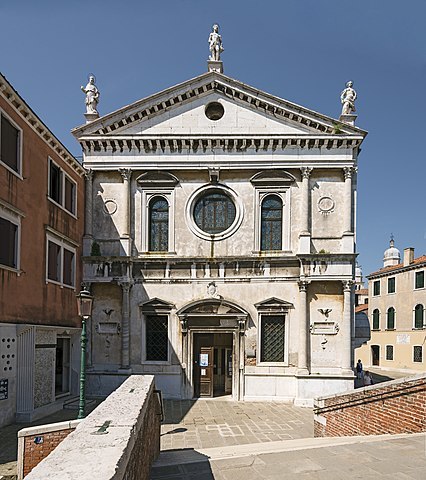 San Sebastiano (Venice) Facade;
San Sebastiano (Venice) Facade; By Didier Descouens – Own work, CC BY-SA 3.0, https://commons.wikimedia.org/w/index...
In 1468, an older building was converted into a church dedicated to Saint Sebastian, who survived martyrdom by the wounds of arrows, but was later clubbed to death. He was one of the chief patrons against plague and pestilence in Europe.

San Giobbe Church, CC BY-SA 4.0 , via Wikimedia Commons
The Church of San Giobbe was named for the Old Testament Saint Job, due to his many sufferings and hoped-for efficacy against the plague. Construction began in 1450 under architect Antonio Gambello and, after a pause of twenty years, was completed by Pietro Lombardo, with funding from Doge (Leader) Cristoforo Moro. It was finally consecrated in 1493.
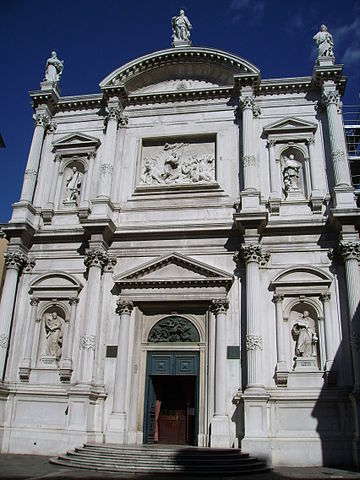 Church of San Rocco, Venice
Church of San Rocco, VeniceSaint Rocco was renowned for being cured miraculously of a plague bubo that he acquired while attending plague patients. In 1485, Venetians stole his body from Montpelier, France, and brought it to the Church of the Brotherhood in Venice. The guild that built the church was overjoyed because they attended to the sick and plague-stricken.
 Chiesa del Redentore (Church of the Redeemer), Venice
Chiesa del Redentore (Church of the Redeemer), VeniceIn 1577, at the end of two years of deadly plague, Venice’s Senate and the Doge ordered the construction of a grand new church, Chiesa del Redentore (Redeemer), designed by the Veneto’s premier architect, Andrea Palladio, to thank God for sparing the fortunate two-thirds of its population.
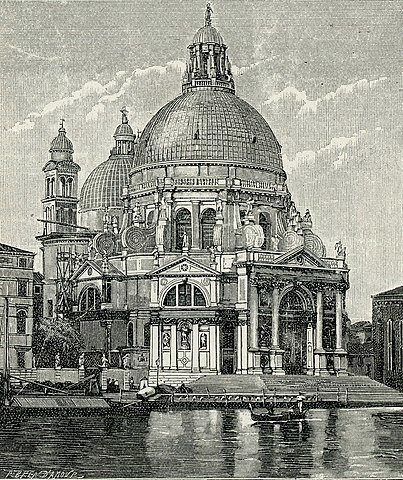 Santa Maria della Salute Church, Venice
Santa Maria della Salute Church, VeniceIn 1630, Plague struck Venice again. The Doge and the Patriarch vowed to build a church, Santa Maria della Salute, in honor of the Virgin Mary, and asked for her help to end the plague. Within a week, the epidemic was over. Architect Baldassarre Longhena won a competition and designed the church.
To learn more about Venice’s “votive/plague” churches, see:
https://www.ncbi.nlm.nih.gov/pmc/articles/PMC1900794/
Readers, when the current pandemic finally ends, what will you do to move forward?
The post Venice says Thanks! appeared first on C.L.R. Peterson, Author.
March 7, 2021
A surprising French connection! 🇫🇷
What do you think of when someone mentions France?
The Eiffel Tower, fantastic cuisine, stylish clothing, or romantic movies?
What about a breeding ground for the Reformed branch of the Protestant Church?
How can this be? France is a Catholic nation.
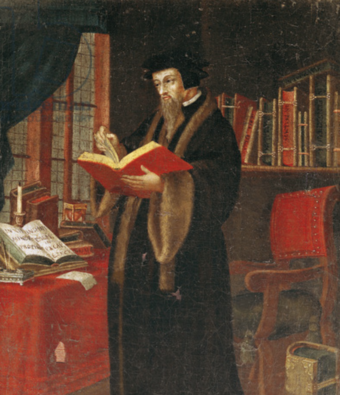
Jean Calvin, a Frenchman, was a key figure of the Reformed (as opposed to the Lutheran) branch of the church that broke away from Roman Catholicism. He fled to Geneva, Switzerland, for his own safety.
Believe it or not, hundreds of Protestant churches sprang up throughout France, and as much as 10% of France’s population considered themselves Huguenots (Reformed Protestants) before persecution began in earnest.
But kings, popes, and powerful families wanted to stay in control, so 36 years of religious wars resulted, followed by more Huguenot rebellions.
Eventually, the Catholic French kings prevailed, and surviving Protestants had to flee or hide their beliefs.
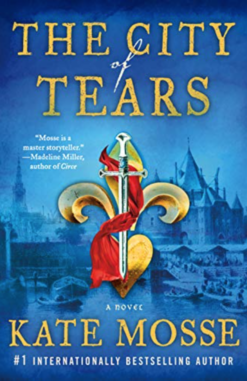
The City of Tears , (The Burning Chambers Series Book 2) an engaging new novel by Kate Mosse, takes place during that volatile period of French history.
Although this was a difficult time for Protestants in France, it’s a very exciting story that I found difficult to put down. Here’s why:
Plot—A wonderful weaving of historical events with emotional arcs, this is a riveting story of a family’s struggles through two decades of France’s religious wars.
Setting—The fully-created world made me feel like I was there, with details about life and locations, but it wasn’t overloaded with description.
Characters— I loved the strong, three-dimensional characters. but I wished I could prevent some unfortunate choices by the heroes. I could sympathize even with the villains.
I haven’t yet read Burning Chambers (Book 1 in this series), but hope to soon so I can fully understand the backstory of City of Tears.
I would give City of Tears a moderate rating, as it includes significant violence (fitting for that time) and fade-out love scenes.
Readers, imagine yourself as a resident of France during this time period. Whatever your beliefs, how would you have responded to religious conflicts—fled, helped your neighbors, hidden your beliefs?
The post A surprising French connection! 🇫🇷 appeared first on C.L.R. Peterson, Author.
February 7, 2021
Saved by the Cow!
The pandemic of the past year has given us all cause for mourning, but today I’m thankful for cows, modern science, and the speedy development of vaccines, and I’m hopeful that all the world’s peoples will gain access to this lifesaving protection.
Renaissance Italy, with great artists such as Michelangelo, Leonardo da Vinci, and many others, is viewed by lovers of art and culture as the golden age of civilization.
During this era, scientists also were learning about how the human body works, even as wave after wave of the Plague decimated Italy and much of Europe and England:
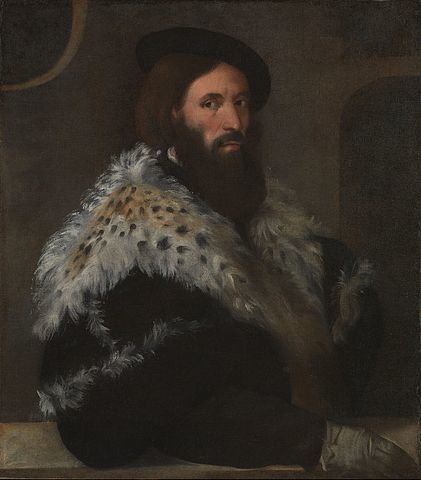 Girolamo FracastoroGirolamo Fracastoro (1478–1553), an Italian doctor and scholar, suggested that epidemics may come from pathogens outside the body. He proposed that these might pass from human-to-human by direct or indirect contact. He also suggested using mercury and the oil from the Palo Santo tree as a cure for syphilis.In 1536, Ambroise Paré became a surgeon in the French army. He developed his ideas practically during 20 years of work, and in 1575 published his book, The Collected Works of Ambroise Paré, proposing changes to the way surgeons treated wounds and amputations. In 1537, Andreas Vesalius became professor of medicine at the University of Padua at the age of just 22. He insisted that his medical students should perform dissections to find out how the human body worked. In 1542, he published his book, The Fabric of the Human Body, with accurate drawings of the human body, giving doctors more detailed knowledge of human anatomy.William Harvey was a physician to English kings James I and Charles I. In 1628, he published An Anatomical Account of the Motion of the Heart and Blood in Animals, proving the principle of the circulation of the blood through the body.Back in the 10th Century, the Chinese were believed to have inoculated themselves with the smallpox virus by blowing pulverized powdery smallpox scabs into a boy’s nostrils. They may have also scraped smallpox matter onto the skin of healthy individuals. Some scholars think this inoculation method was first discovered in India and then the practice spread to China.But alas, no effective vaccine for the Plague existed for centuries in Europe! Vaccinations weren’t developed to prevent illness in the European world until 400 years after the Black Death first struck Italy.
Girolamo FracastoroGirolamo Fracastoro (1478–1553), an Italian doctor and scholar, suggested that epidemics may come from pathogens outside the body. He proposed that these might pass from human-to-human by direct or indirect contact. He also suggested using mercury and the oil from the Palo Santo tree as a cure for syphilis.In 1536, Ambroise Paré became a surgeon in the French army. He developed his ideas practically during 20 years of work, and in 1575 published his book, The Collected Works of Ambroise Paré, proposing changes to the way surgeons treated wounds and amputations. In 1537, Andreas Vesalius became professor of medicine at the University of Padua at the age of just 22. He insisted that his medical students should perform dissections to find out how the human body worked. In 1542, he published his book, The Fabric of the Human Body, with accurate drawings of the human body, giving doctors more detailed knowledge of human anatomy.William Harvey was a physician to English kings James I and Charles I. In 1628, he published An Anatomical Account of the Motion of the Heart and Blood in Animals, proving the principle of the circulation of the blood through the body.Back in the 10th Century, the Chinese were believed to have inoculated themselves with the smallpox virus by blowing pulverized powdery smallpox scabs into a boy’s nostrils. They may have also scraped smallpox matter onto the skin of healthy individuals. Some scholars think this inoculation method was first discovered in India and then the practice spread to China.But alas, no effective vaccine for the Plague existed for centuries in Europe! Vaccinations weren’t developed to prevent illness in the European world until 400 years after the Black Death first struck Italy.Finally, the cow (and a wise physician) saved England from smallpox!

https://commons.wikimedia.org/w/index...
Edward Anthony Jenner (1749-1823), an English doctor and scientist, created the smallpox vaccine and pioneered vaccinations. He noticed that milkmaids tended to be immune to smallpox, but did come down with cowpox (milder than smallpox). He suspected the pus from the cowpox blisters might protect the girls from smallpox.
In May 1796, he found a young dairymaid who had fresh cowpox lesions on her hand. On May 14, he used matter from her lesions to inoculate an eight-year-old boy who had never had smallpox. The boy became slightly ill over the course of the next 9 days but was well on the 10th. On July 1, Jenner inoculated the boy again, this time with smallpox matter. The boy was immune to smallpox because of the cowpox “vaccine.”Why was it called a “vaccine?” Jenner paid homage to the cow, which in Latin means “vacca,”We can be thankful for the centuries of research which brought us the concept of vaccines, as well as modern-day researchers who worked so hard and quickly to develop them in the past year!
Interested in novels touching on the history of medicine? See this discussion: https://www.rcpe.ac.uk/college/journal/novel-approach-history-medicine-look-relationship-between-fiction-and-medical
Readers, please share your favorite stories of inspiring moments of medical history!
The post Saved by the Cow! appeared first on C.L.R. Peterson, Author.
January 7, 2021
Is there anything new under the sun?
After only one week of this new year, you may agree with me that 2021 will be unique and unforgettable.
Just as new events emerge from the background of the past, so new stories (especially historical novels) spring up, building on the raw material of old stories.
This month, I’m pulling back the curtain to reveal a few of the pleasures and challenges of writing stories that combine the old with the new.
What’s fun?
immersing myself in a bygone, faraway culture (and visiting the location virtually or in person)creating and getting to know my charactersgetting to know actual people who lived then and there, sometimes giving them roles in my storiesdeveloping a plot and themes
What’s challenging?
Staying true to history (what could have happened then)Discovering details of life that make the story seem realCreating an entertaining, believable plot
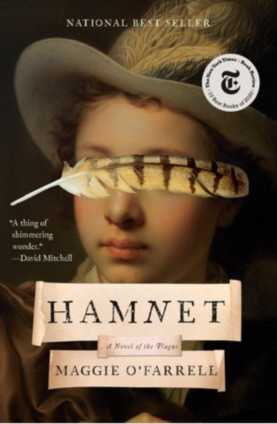
Hamnet, an acclaimed 2020 novel, is a recent example of a story built on an existing historical foundation.
Modern-day techniques and twists breathe new life into the life stories of William Shakespeare and his family.Hamnet, Shakespeare’s only son, died at the age of eleven (probably of the plague), and the novel focuses on the lives of his family members before and after his death.Setting details (mostly unpleasant) made me feel I was there (and glad I didn’t live then)Author Maggie O’Farrell’s deep emotional portrayals of her characters and focus on their unusual backgrounds, especially William Shakespeare and his wife Agnes/Anne, brought them to lifeThe exploration of the lasting and differing effects of grief on the characters raised questions about the plague’s impact—perhaps like PTSD?–on families and societiesThe link between the life and death of Shakespeare’s son, Hamnet, and the writing of the play, Hamlet, is a key part of the story. The author points out that in Shakespeare’s time, spelling wasn’t uniform, so Hamnet and Hamlet were considered the same name.A few caveats:Use of present tense can become tiringSwitching characters and time periods without warning in succeeding scenes is jarring and took me out of the storyRating of Adult for an on-screen love scene
Readers, what new stories based on old ones have you enjoyed?
If you’ve read Hamnet, what did you think of it?
The post Is there anything new under the sun? appeared first on C.L.R. Peterson, Author.
December 7, 2020
THE CASE OF THE MISSING HUGUENOTS
Today I have a historical mystery for you, based on my novel research, with a few questions and clues to help solve it.
Who were the Huguenots?
French Protestants who held to the Reformed, or Calvinist, tradition of ProtestantismAt their peak,they made up as much as 10% of the French population
Why did they go missing from France?
The French Roman Catholic clergy could not accept the Huguenots’ increased influence and worked to deprive them of their rightsKing Louis XIV believed that unity in the state was extremely difficult to maintain where two or more churches were tolerated.The king intensified the persecution of Huguenots:Dragonnades—soldiers were billeted in Protestant homes with permission to behave as brutally as they wishedChurches were destroyedCertain professions were put out of their reachTheir children were taken away from their parents and brought up as Roman CatholicsOn Oct. 18, 1685, Louis XIV pronounced the revocation of the Edict of Nantes, which had guaranteed political and religious rights
Where did they go?
NetherlandsSwitzerlandEnglandIrelandScotlandPrussiaDenmarkSwedenFinlandAmericaSouth Africa
What was the result in France?
Huguenot persecution greatly damaged the reputation of Louis XIV abroad, particularly in England. Both kingdoms became bitter enemies and fought each other in a series of warsMany Huguenots had been urban people in commerce and industry, so their absence hurt France in the Industrial RevolutionIn The Protestant Ethic and the Spirit of Capitalism, German sociologist Max Weber, argued that the supposedly Protestant values of hard work, thrift, efficiency, and orderliness contributed to the economic success of Protestant groups in the early stages of European capitalism.Alain Peyrefitte, the French Catholic author of Le Mal Français, argues that the absence of supposedly Protestant values (hard work, thrift, efficiency, and orderliness) caused France to lag behind other nations socially and economically.
Many novels have been written about Huguenots, and I’ll highlight one from the 19th century and one from the 21st century:
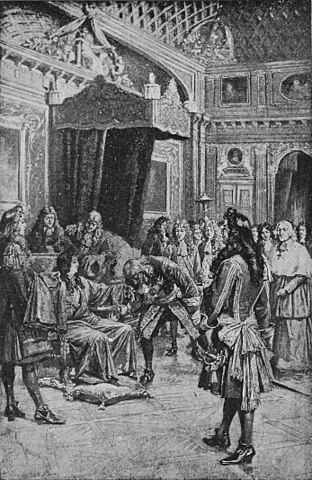
The Refugees, by Arthur Conan Doyle, 1893
Believe it or not, the author of the Sherlock Holmes mystery stories also wrote this novel focused on Huguenots and where some emigrated during the reign of Louis XIV. I just discovered this novel, and I look forward to reading it soon.

Merchants of Virtue, (Book I of The Huguenot Connection) by Paul C.R. Monk
Based on a true story, this novel follows one French Huguenot family as King Louis XIV consolidated his power by whittling away Protestants’ rights, tolerating no political or religious opposition, impacting individuals of all ages and ranks of society.Shows how ordinary people’s toleration of injustice on a small scale can lead, step by step, to great evilCould have used more light moments, but, as with stories about the Holocaust era, humor and good times would not ring true with the facts of history
Hindsight shows us the tragic choices made by France’s leaders hundreds of years ago and their impact on that nation and the world. They couldn’t embrace the idea that a cultural melting pot could enrich their society.
We can learn from their mistakes and reach out to people of diverse backgrounds, breaking down stereotypes and prejudice.
I wish you peace and health in this holiday season.
The post THE CASE OF THE MISSING HUGUENOTS appeared first on C.L.R. Peterson, Author.
November 6, 2020
Heroes, Kings, Cannons–Twists in Historical Fiction
We love to read novels that keep us turning pages, but what keeps you reading? Maybe it’s:
A hero/heroine you identify with and root forA villain you love to hateAn historical personality (king, queen, pope, rebel) you enjoy observing ‘in action’
But how often does technology drive a novel’s plot, influence the story’s winners and losers, and keep us on the edge of our seats?
Maybe you’ve read a fascinating novel or seen a movie with a plot involving technology, such as:
Enigma encryption device used by Germany (and decrypted by Britain and its allies) during World War IIWright brothers’ airplane (1903)Printing press (1440)Oil painting (~1410)Compass (in wide use by 1300s)Magnifying lenses (1200s for weak-sighted, 1500s-1600s for microscopes and telescopes)
Recently, I discovered a fascinating new novel set in the reign of England’s Henry VIII, in which new cannons designed in Italy played a central role in the plot.
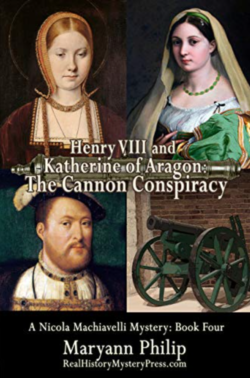
Henry VIII and Katherine of Aragon: The Cannon Conspiracy, by Maryann Philip (RealHistoryMystery-Press.com, ©2020)
My brief review:
King Henry VIII of England orders a new type of Italian cannon to protect his life, family, and reign. Although this novel’s premise may sound dry and technical, it develops into an intriguing plot.The story is told from the point of view of the heroine, a young Italian woman who accompanies the cannons to England. She turns out to be a sharp-eyed sleuth who turns her attention to a mystery that proves key to Henry’s reign.Along the way, I learned more about the motivations of Henry’s enemies, both domestic and foreign, who sought to destroy him.The author’s well-developed portrayal of Katherine of Aragon especially intrigued me—a marked contrast from common stereotypes about her.
An interesting and enjoyable read!
Readers, please share your favorite novels involving a technological innovation!
The post Heroes, Kings, Cannons–Twists in Historical Fiction appeared first on C.L.R. Peterson, Author.
October 8, 2020
Hidden Gems from Bygone Times
Lucia, my protagonist, is approaching the end of her next adventure. Along the way, I’ve discovered stories from history that came to life as I read them.
This month, I’ll highlight two fascinating stories:

Fontevraud (English spelling, Fontevrault) is a French Benedictine abbey two and a half miles south of the Loire River, in a wooded valley in the province of Anjou.
Although it contained both male and female Benedictine monastic communities,the men labored to serve the spiritual and material needs of the womenthe women lived a silent life of contemplationA woman (the abbess) was always in charge of the entire abbey (including the men), overseeing renovation and construction over the centuries.French kings and queens supported the abbey’s construction projects, including:Henry II and Eleanor of AquitaineLouis XV, whose three youngest daughters were educated at the abbey (after a new complex was built with apartments, chapels, gardens, and an orangerie).After the French Revolution, the abbey was used as a prison, but now has been restored and open to visitors. See: https://www.fontevraud.fr/en/royal-abbey/discover-fontevraud-royal-abbey/To learn more about Fontevrault, also see this article: https://core.ac.uk/download/pdf/48829063.pdf
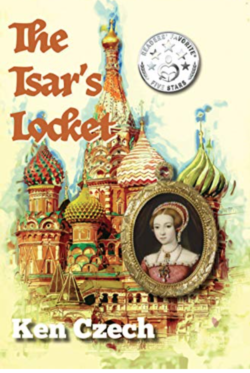
If Queen Elizabeth wanted to ally England and Russia against Spain and the Roman Church, how could she do it? This fascinating adventure story imagines how a betrothal locket delivered to Tsar Ivan the Terrible could lead to a marriage and an alliance.
A suspenseful novel, The Tsar’s Locket is filled with rich descriptions of costumes, scenery, buildings and interiors. It offers a window into travel from England to Russia, and throws readers into the dangerous, violent world of spies and conflicts between nations and faiths in the Elizabethan era.
The main characters offer insights into how different life could be in England for people at this time, depending on one’s place in society. I enjoyed observing how the events of the story changed them.
Note to readers: Romance is also an important element of The Tsar’s Locket. Most of the novel is written at a PG-13 level, but it also contains a small amount of non-graphic sex.
Readers, what are your favorite hidden gems?
The post Hidden Gems from Bygone Times appeared first on C.L.R. Peterson, Author.



